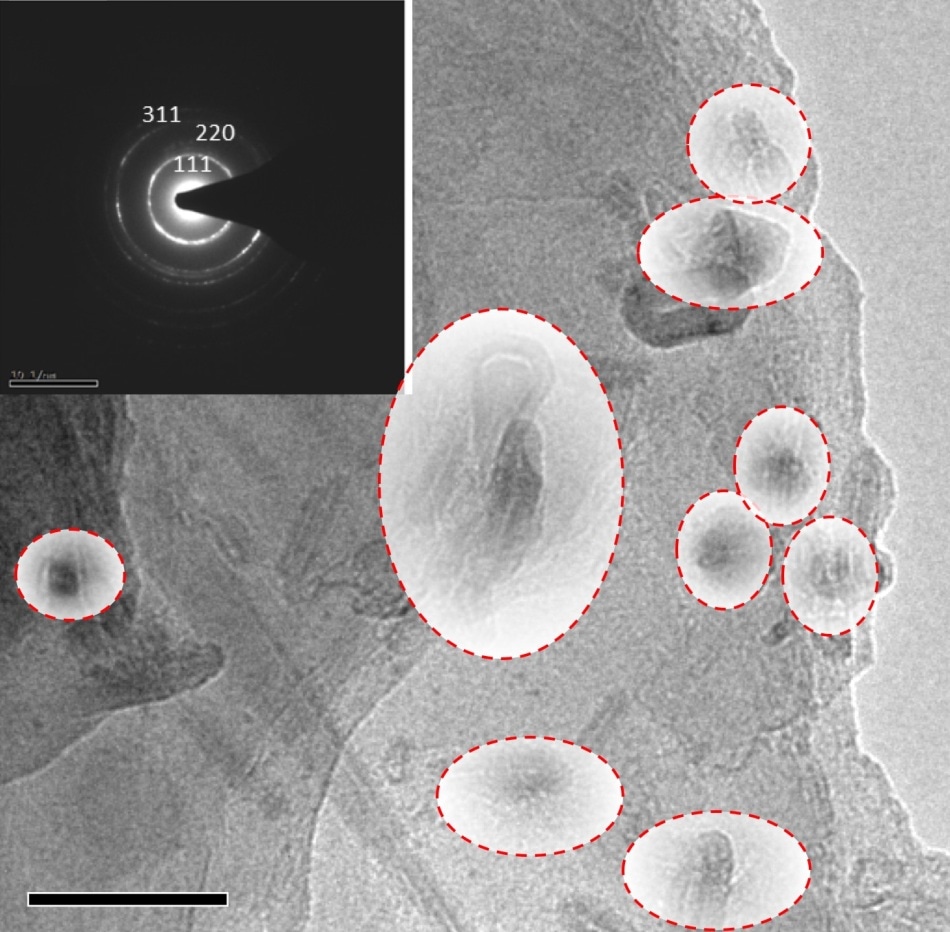Sep 8 2016
 Transmission electron microscope images show nanodiamonds in samples of nanotubes fired at a target at high velocity. The insert shows the diffraction pattern identifying the formations as nanodiamonds. (CREDIT: Ajayan Group/Rice University)
Transmission electron microscope images show nanodiamonds in samples of nanotubes fired at a target at high velocity. The insert shows the diffraction pattern identifying the formations as nanodiamonds. (CREDIT: Ajayan Group/Rice University)
Researchers at Rice University are creating nanodiamonds and other forms of carbon by crushing nanotubes against a target at great speeds. Nanodiamonds won't make anyone rich, however the method of producing them will enhance the knowledge of scientists who design structures that resist damage caused by high-speed impacts.
The diamonds are a result of a comprehensive study on the ballistic fracturing of carbon nanotubes at varying velocities. The results revealed that such high-energy impacts caused atomic bonds present in the nanotubes to split and sometimes recombine into different structures.
The study was led by the labs of materials scientists Pulickel Ajayan at Rice and Douglas Galvao at the State University of Campinas, Brazil. The aim was to help aerospace engineers create ultralight materials for satellites and spacecraft that can endure impacts from high-velocity projectiles like micrometeorites.
The study is published in the American Chemical Society journal ACS Applied Materials and Interfaces.
Knowing how to recombine the atomic bonds of nanotubes will provide scientists with clues to create lightweight materials by rearranging those bonds, explained co-lead author and Rice graduate student Sehmus Ozden.
Satellites and spacecraft are at risk of various destructive projectiles, such as micrometeorites and orbital debris. To avoid this kind of destructive damage, we need lightweight, flexible materials with extraordinary mechanical properties. Carbon nanotubes can offer a real solution.
Sehmus Ozden, Graduate Student, Rice University
The team conducted an experiment at Rice where they placed multi-walled carbon nanotubes into spherical pellets and then fired them at an aluminum target in a two-stage light-gas gun. The results from impacts at three different speeds were later examined.
At a low velocity of 3.9 km per second, many of the nanotubes remained intact. Some nanotubes were able to withstand higher velocity impacts of 5.2 km per second. However, only a few were found among the samples crushed at a hypervelocity of 6.9 km per second.
The researchers discovered that a majority of the nanotubes split into nanoribbons, verifying previously conducted experiments.
Co-author Chandra Sekhar Tiwary, a Rice postdoctoral researcher, observed that the few nanoribbons and nanotubes that survived the impact were frequently welded together, as examined in transmission electron microscope images.
In our previous report, we showed that carbon nanotubes form graphene nanoribbons at hypervelocity impact. We were expecting to get welded carbon nanostructures, but we were surprised to observe nanodiamond as well.
Chandra Sekhar Tiwary, Postdoctoral Researcher, Rice University
Ajayan said that the orientation of nanotubes to each other and with respect to the target, and the number of tube walls were as significant to the final structures as the velocity.
“The current work opens a new way to make nanosize materials using high-velocity impact,” said co-lead author Leonardo Machado of the Brazil team.
Machado is a graduate student at the State University of Campinas, Brazil, and the Federal University of Rio Grande do Norte, Brazil. Co-authors are Rice’s Robert Vajtai, an associate research professor, and Enrique Barrera, a professor of materials science and nanoengineering, and Pedro Alves da Silva of the State University of Campinas and the Federal University of ABC, Santo Andre, Brazil. Ajayan is chair of Rice’s Department of Materials Science and NanoEngineering, the Benjamin M. and Mary Greenwood Anderson Professor in Engineering and a professor of chemistry.
The study was supported by the Department of Defense, the U.S. Air Force Office of Scientific Research and its Multidisciplinary University Research Initiative, NASA’s Johnson Space Center, the Sao Paulo Research Foundation, the Center for Computational Engineering and Sciences at Unicamp, Brazil, and the Brazilian Federal Agency for Support and Evaluation of Graduate Education.
Video Credit: Rice University/Youtube.com